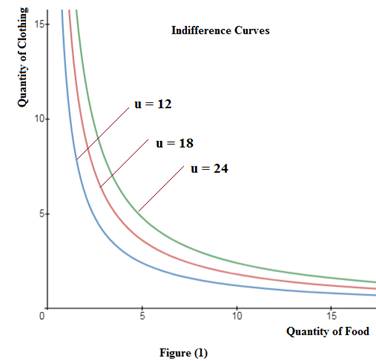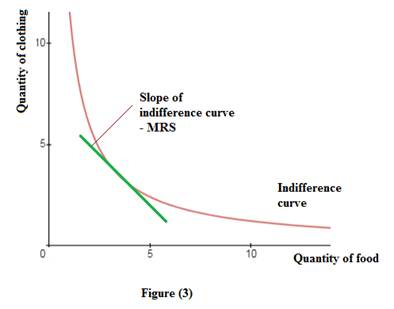
(a)
Graph of indifference curves corresponding to u =12, u =18, and u=24. Optimal consumption of food and clothing using the graph.
Explanation of Solution
The consumer prefers food (F) and clothing (C). The per-unit price of food and clothing is equal to $1 and $2 respectively. And the maximum amount that the consumer can spend on both the goods is equal to $12.
The utility function of the consumer is given as follows:
Also, the
And the budget constraint of the consumer can be given as follows:
The figure (1) below depicts the graph of indifference curves corresponding to u =12, u =18, and u=24. Here, the X-axis measures the quantity of food and the Y-axis measures the quantity of clothing.

At the optimum level of consumption, the slope of the indifference curve is equal to the slope of the budget constraint. Graphically, the point at which the budget line is tangent to the indifference curve gives the optimal level of consumption.
The figure (2) below plots the budget constraint along with the indifference curves of the consumer.

At point A, budget constraint is tangent to an indifference curve. Thus, the optimal level of F and C is equal to 6 units and 3 units respectively.
(b)
Optimal consumption of F and C using algebra.
Explanation of Solution
The rate at which consumer is willing to sacrifice some units good F to get an additional unit of good C is known as the marginal rate of substitution (MRS).
It measures the slope of the indifference curve. The ratio of the price of good F to the price of good C measures slope of the budget constraint.
At the optimum level of consumption, the slope of the indifference curve is equal to the slope of the budget constraint. Mathematically, it is expressed as follows:
Plug the given expressions of the marginal utilities and the values of the prices in (2).
Put (3) in (1).
Plug value of C equal to 3 in (3).
Thus, the optimal level of F and C is equal to 6 units and 3 units respectively.
(c)
The marginal rate of substitution of F for C at the optimum level of consumption.
Explanation of Solution
Mathematically, the marginal rate of substitution of F for C is expressed as the ratio of marginal utility of good F to the marginal utility of good C, as follows:
Graphically, the marginal rate of substitution of F for C can be expressed as the slope of the indifference curve of the consumer, as shown in figure (3) below:

(d)
Whether the consumer's marginal utility per dollar spent on F is greater than marginal utility per dollar spent on C or not. And optimal substitution between F and C.
Explanation of Solution
It is given that the consumer purchases 4 units of both the goods F and C from the given level of budget. Using (2), the condition of optimum level of consumption is as follows:
Here,
Plug the values of marginal utilities of good F and good C and their respective prices.
Thus, the marginal utility per dollar spent on F is equal to 4/1. And marginal utility per dollar spent on C is equal to 4/2. This implies:
Thus, consumer's marginal utility per dollar spent on F is greater than marginal utility per dollar spent on C. In such case, a consumer should consume more of good F and less of good C to maximize utility from the given level of income.
Want to see more full solutions like this?
Chapter 4 Solutions
EBK MICROECONOMICS


 Microeconomics: Principles & PolicyEconomicsISBN:9781337794992Author:William J. Baumol, Alan S. Blinder, John L. SolowPublisher:Cengage Learning
Microeconomics: Principles & PolicyEconomicsISBN:9781337794992Author:William J. Baumol, Alan S. Blinder, John L. SolowPublisher:Cengage Learning
 Economics (MindTap Course List)EconomicsISBN:9781337617383Author:Roger A. ArnoldPublisher:Cengage Learning
Economics (MindTap Course List)EconomicsISBN:9781337617383Author:Roger A. ArnoldPublisher:Cengage Learning





